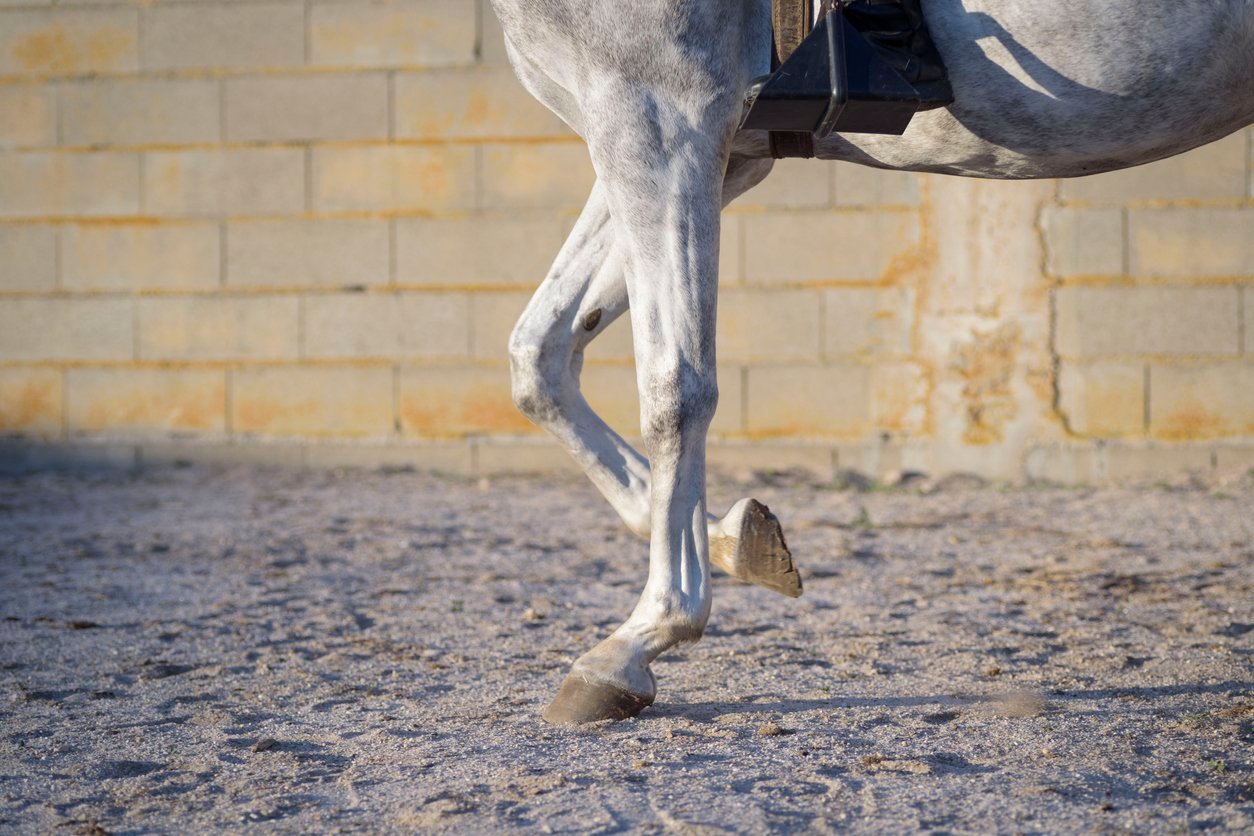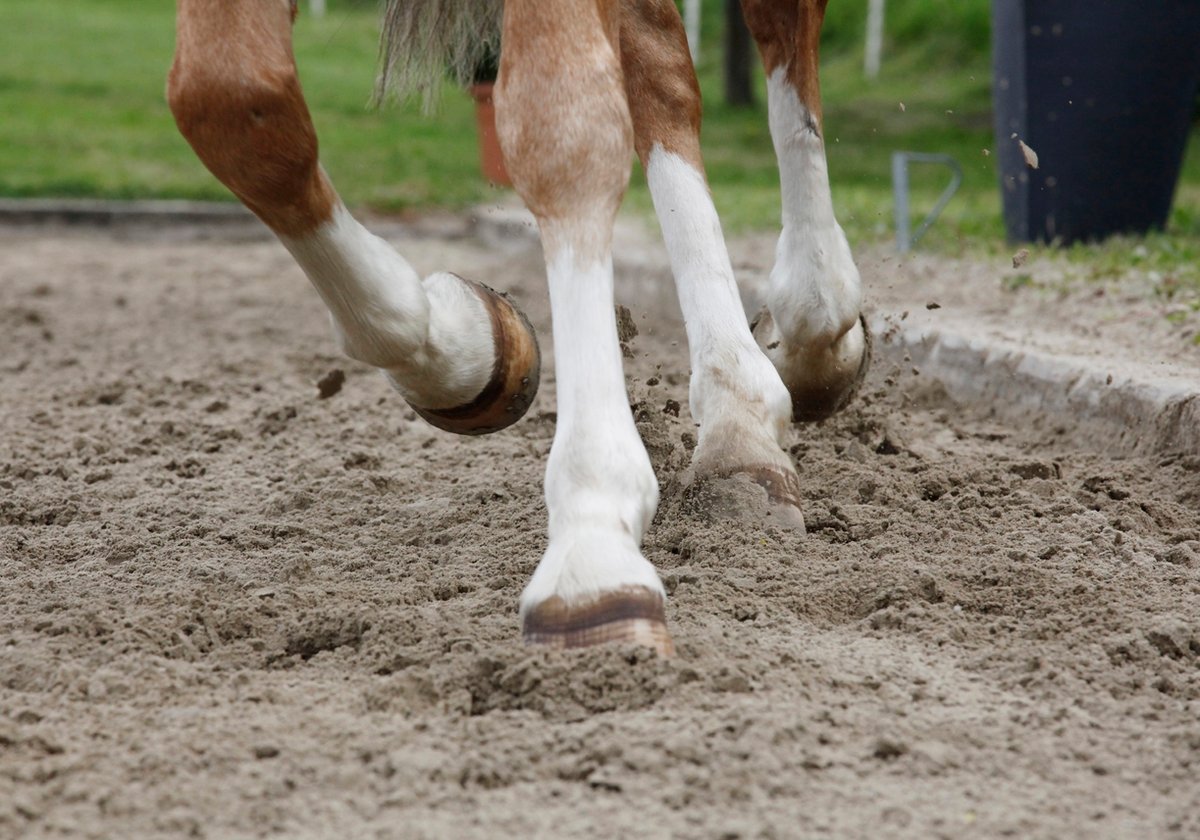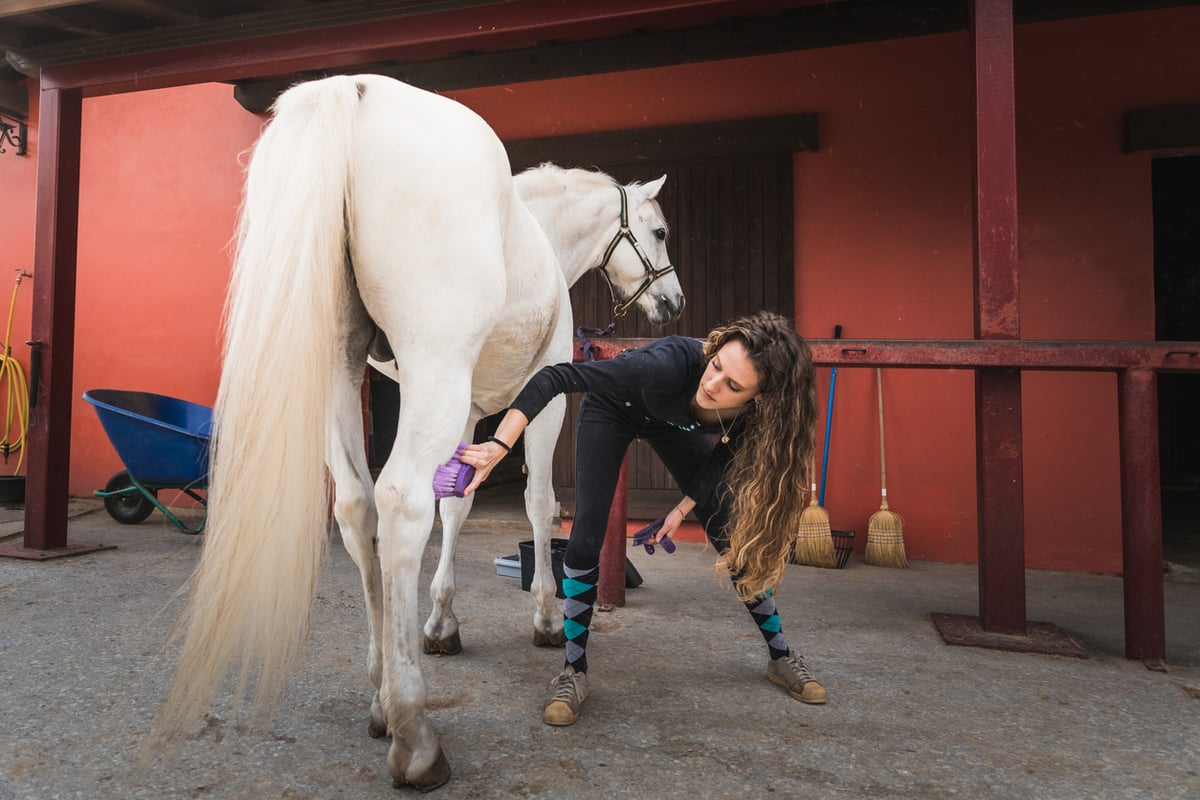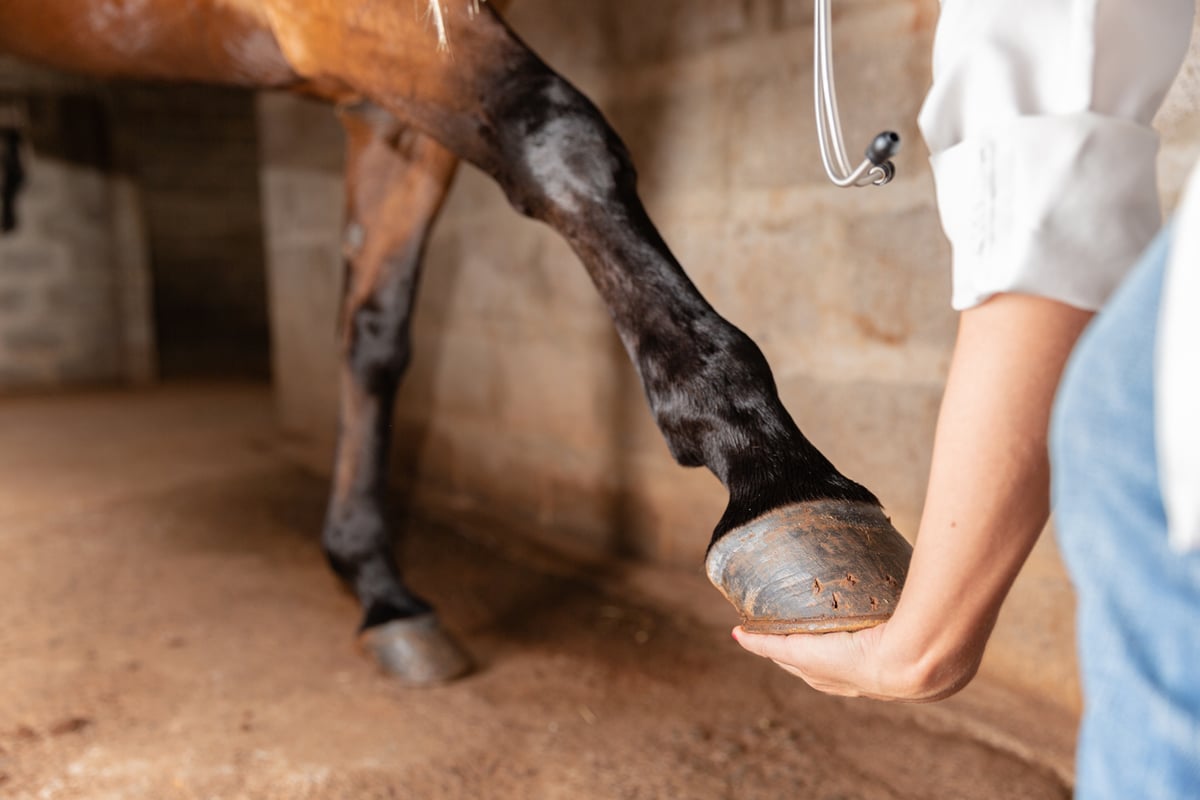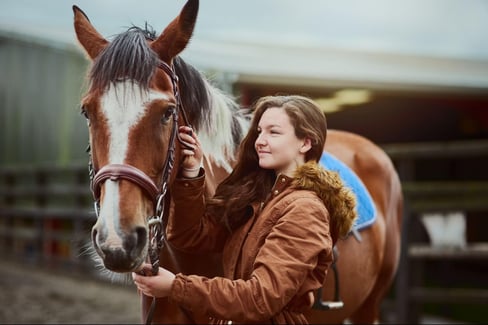Table of Contents
Horse leg injuries can be a stressful time for your horse, and for you.
As horse lovers, trainers, breeders, and more, we want our horses to be healthy and happy at all times.
Leg injuries are not only painful for your horse, but they can be a reason for retirement if your horse competes.
One common injury for performance and sport horses is a bowed tendon.
In some cases, horses suffering from a bowed tendon can recover on their own with some rest. But in other cases, the injury can be more serious and require veterinary treatment.
The types, causes, symptoms, treatment, and recovery of horse bowed tendons are explored throughout this article.
Horse Bowed Tendon Definition
What is a bowed tendon in a horse?
The technical answer is that it’s swelling in the digital flexor tendons of your horse.
Let’s break it down a little bit more.
First of all, tendons are what attach bones to muscles so that your horse can move. They have an elastic, rubber band-like quality where they can flex, bend, and move as necessary so your horse can bend, flex and move.
The digital flexor tendons are tendons in the limbs of your horse.
Here’s a diagram depicting exactly what and where the digital flexor tendons in your horse are:
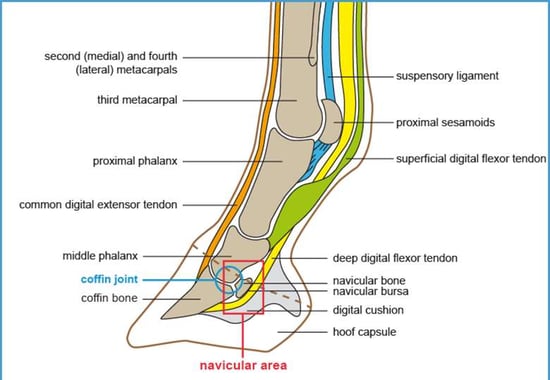
The digital flexor tendon includes:
- The superficial digital flexor tendon, which runs up the ankle and leg of the horse.
- The deep digital flexor tendon, which is located in the foot of your horse and runs along the back of the hoof and up your horse’s leg.
Based on the location of these tendons, you can imagine how much they flex and move and how much pressure they take every time a horse walks, canters, or gallops.
An injury to one of the tendons can significantly impact how well your horse can move, resulting in pain and a lame horse.
Swelling in the superficial and deep digital flexor tendons are what causes bowed tendons in horses.
It’s more common for bowed tendons to appear on the superficial digital flexor tendon rather than the deep digital flexor tendon.
Bowed tendons come in various severities, depending on the type, location, intensity of the swelling/injury, etc.
The severity of the bowed tendon horse will affect how the injury heals and how long it takes for the injury to heal.
However, in most cases, your horse will be “right as rein” in about half a year or more.
What Does a Bowed Tendon Look Like on a Horse?
Now that you understand what bowed tendon in horses is and the area of the horse’s leg where it occurs, let’s dig into what a bowed tendon looks like.
First, here’s a diagram depicting what a bowed tendon looks like in the horse’s leg:
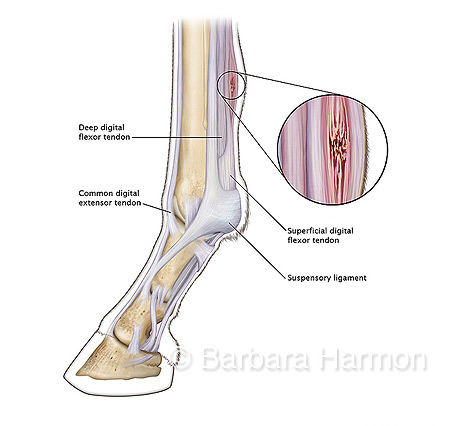
Where the tendon has become swollen in the diagram, results in a bowed tendon.
What’s happening in the tendon when it becomes bowed is that fibres within it have torn (usually inner fibres first), causing inflammation and swelling.
Now here’s an image of what a bowed tendon actually looks like if you’re viewing the horse’s leg from the back:
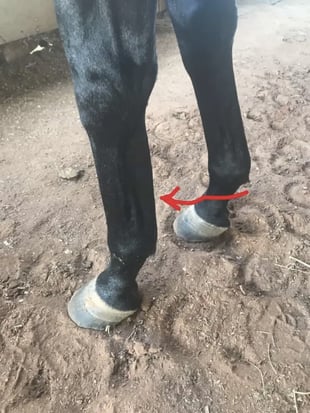
You can see that the only visible clue that something is wrong with the horse’s leg is some swelling.
It may not be the easiest thing to notice unless you’re really paying attention to your horse, so it’s important to keep an eye out for other symptoms that may lead to the conclusion that your horse has a bowed tendon.
How to Tell if My Horse Has a Bowed Tendon?
Your horse may be acting strangely, lifting and otherwise avoiding putting weight on the affected leg. But how else can you tell if your horse may have a bowed tendon?
Some bowed tendon horse symptoms include:
Swollen or ‘Bowed’ Spot On Your Horse’s Leg
The first sign of a bowed tendon injury is a swollen or ‘bowed’ spot on your horse’s leg in the cannon bone region. Horse bowed tendons occur when the tendon is strained beyond its limits, causing the collagen fibres to tear and create this bow-like swelling.
Swollen Area May Feel Warm to the Touch
Once the tendon fibres tear, it causes acute internal bleeding and inflammation, making the area very warm to touch. The swelling also occurs around the tendon due to an accumulation of fluid, called edema.
Your Horse May Be Lame Or Limping
Equine bowed tendons cause a horse to become lame or start limping. A lame horse is a horse whose gait has changed. The horse will elevate its heel to relieve the tension on the tendon and ease the pain. The severity of the limping will depend on the severity of the injury.
Diagnosing Horse with Bowed Tendon
Diagnosing bowed tendon in horses must be done by an equine veterinarian. In addition to asking you about your horse’s symptoms and checking their vital signs, your veterinarian will perform one or more of the following:
- Check the temperature of the area compared to elsewhere on the limb.
- Perform physical palpitations of the affected area and surrounding limb.
- Conduct an ultrasound scan of the tendon and surrounding area.
If your veterinarian chooses to conduct an ultrasound, the scan allows them to see the precise structure of the tendon and any damage that’s occurred. An ultrasound is a great tool for allowing your vet to properly treat and asses bowed tendon injuries.
Types of Bowed Tendon in Horses
There are different types of bowed tendons in horses, outlined in the table below.
| Type of Bowed Tendon |
Description |
| Low Bowed Tendon Horse |
A low bow is when the area of the tendon that’s torn or ‘bowed’ is the lower portion of the deep digital flexor tendon |
| High Bowed Tendon Horse |
A high bow is when the affected area is higher up the tendon |
| Middle Bowed Tendon Horse |
A middle bow is when the affected area is in the middle area of the tendon |
| Full Bowed Tendon Horse |
A full bow is when all three areas are affected |
| Front Leg Bowed Tendon |
Bowed tendons in the front legs are more complicated to rehabilitate than those in the back |
| Hind Leg Bowed Tendon |
Hind leg bowed tendons are easier to rehabilitate than those in the front. |
Bowed Tendon Horse Causes
There are usually two distinct causes of bowed tendons horses:
- A one-time injury, such as stepping in a gopher hole
- Constant wear and tear, which will happen with horses in competition, in training, or under a heavy workload.
One-Time Stress Issues
A bowed tendon happening because of a one-time issue, like the gopher hole example above, is an unfortunate accident where your horse has a misstep and trips, and the stress from that causes tears in the tendon’s fibres, which results in a bowed tendon.
Trying to ensure that any holes that appear in the pasture where you turn out your horse are filled is one solution, as well as being careful to avoid any obstacles that your horse could trip over when you’re riding them. But regardless of how cautious we are, accidents can happen, so it’s important to recognize the signs of a bowed tendon horse so that you can seek treatment for your horse as soon as possible.
Wear and Tear
The other cause of bowed tendons is constant wear and tear from being an active horse. The constant stress put on the tendons, bones, ligaments, and muscles of your horse’s legs when they are being constantly exercised can heighten your horse’s chances of developing an injury.
Suppose you’re training a thoroughbred racehorse, a standardbred racehorse, or a horse being used for other English or Western sports. In that case, you’ll need to take precautions to ensure they don’t get injured.
Training, racing, competing, and physical labour can cause injury, such as bowed tendons, over time.
One of the most important things you can do for your active horse is to give them horse supplements for their joints. TRI-ACTA H.A. is a powerful equine joint supplement that has been developed for active or aging horses that need extra support to ensure their joints stay healthy.
Key ingredients in TRI-ACTA H.A. include:
- Glucosamine and chondroitin, which work together to help prevent the breakdown of cartilage in your horse’s joints.
- MSM, a natural anti-inflammatory that helps provide relief for painful joints.
- Hyaluronic acid, which assists with joint lubrication to minimize friction and provide resistance to shock in weight-bearing joints.
TRI-ACTA H.A. for Equine
Our maximum strength formula is perfect for horses that are ageing, experiencing arthritis and stiffness, are in training and competition, or under a heavy workload.
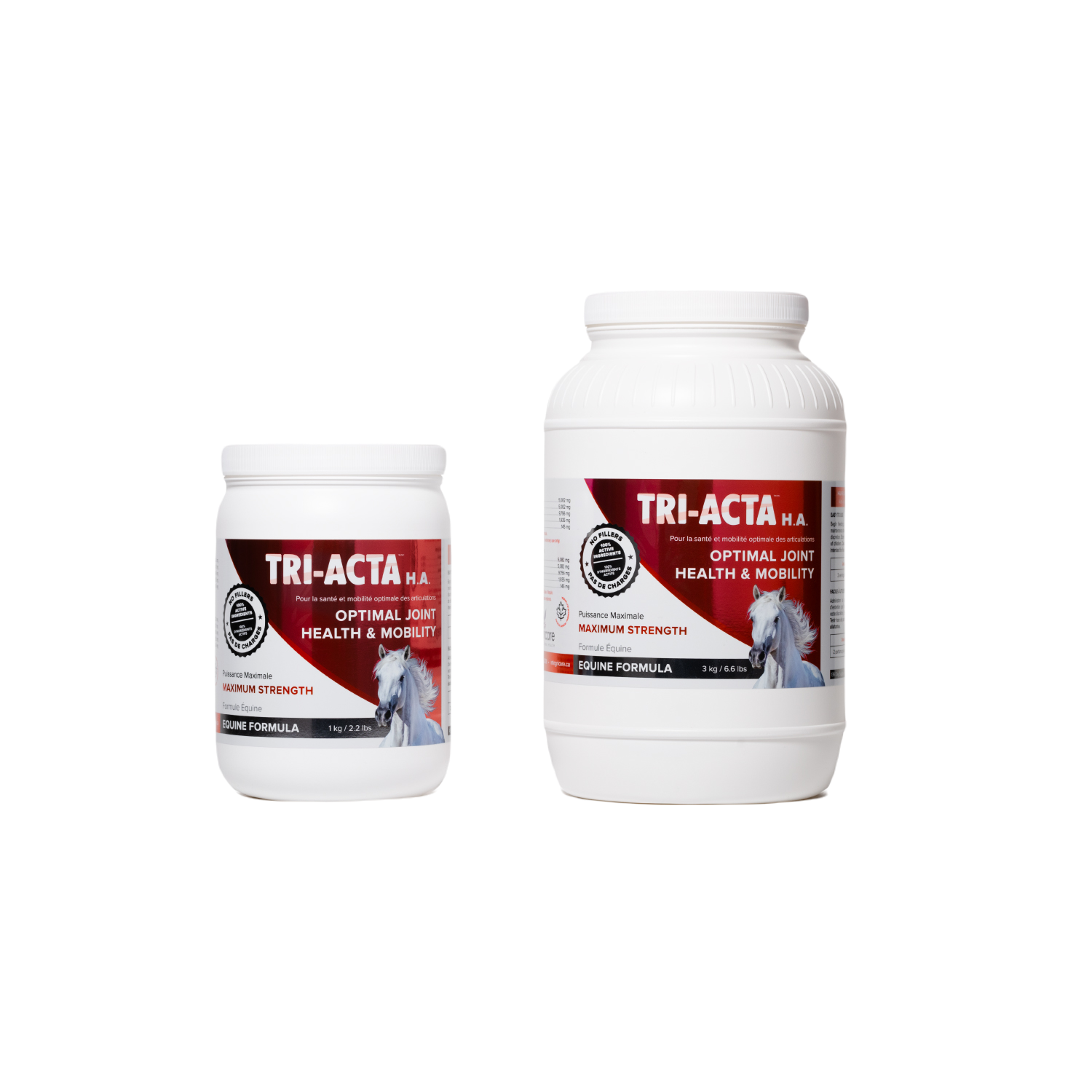
Bowed Tendon Horse Prevention Tips
Preventing bowed tendon horse requires a holistic approach to your horse’s overall health, which includes:
- Ensuring your horse has the proper nutrition
- Giving your horse equine supplements
- Allowing your horse to have proper rest
- Maintaining proper grooming and hygiene
- Regular and proper vet care
Ensuring Your Horse Has the Proper Nutrition
Equine nutrition is an important part of maintaining your horse’s health. You’ll want to ensure you’re giving them a proper diet to keep your horse healthy and strong at a healthy weight.
And horses eat a LOT as it is. They should be eating 1% of their body weight.
Horses will maintain most of their diet by eating forage, especially if you let them pasture throughout the day.
Giving Your Horse Supplements
However, you may want your horse to get some extra nutrients they can’t get from forage alone.
This is where horse supplements for things like joint health and mobility can be beneficial for keeping your horse mobile and strong.
For instance, TRI-ACTA for Equine uses ingredients like glucosamine for horses, chondroitin, and MSM to repair cartilage, prevent its breakdown and reduce pain and inflammation in joints to increase and/or maintain mobility. It is one of the best horse health supplements for prevention, maintenance, and dietary completeness to ensure the joint structures are supported properly, which can help avoid injuries like bowed tendons.
If you’re interested in starting to provide your horse with horse nutrition supplements, talk to your vet about what would be best.
TRI-ACTA for Equine
Providing preventative support for younger horses and helping mitigate the early onset of joint degeneration and other mobility issues.
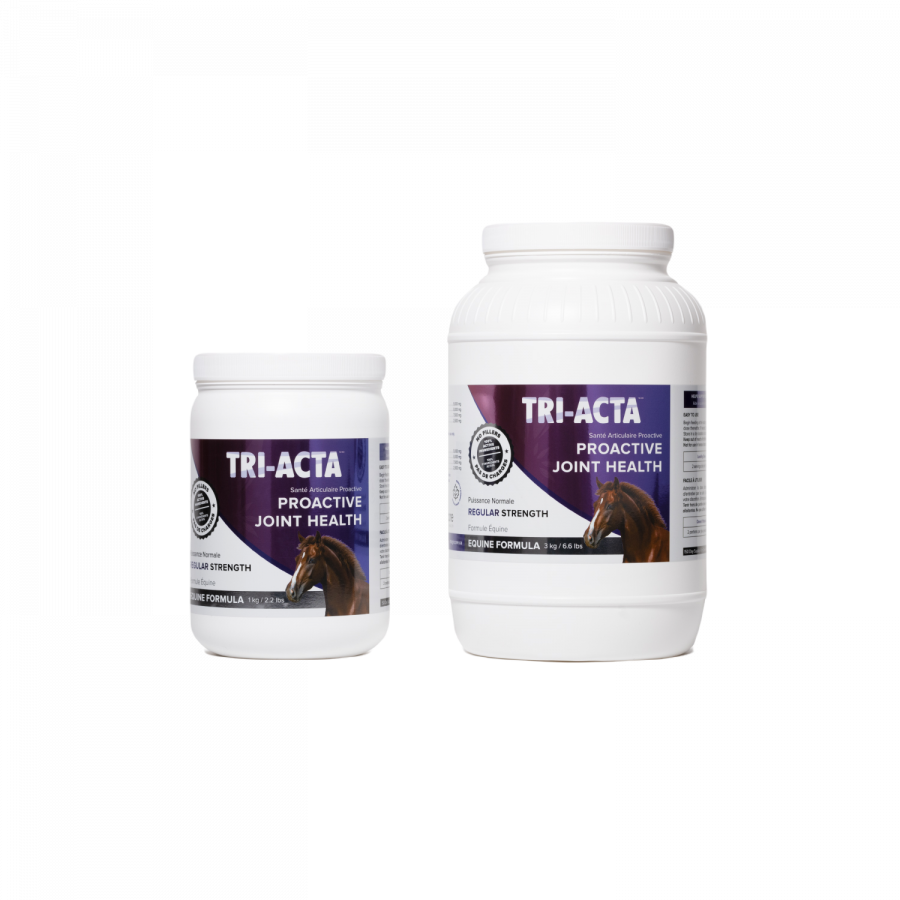
Allowing Your Horse to Rest
Just like it’s not good for you to go go go all the time, it’s also not good for your horse to over-exert them. Make sure you’re giving your horse a proper amount of time to rest, especially if it’s an active horse due to racing, jumping, or being used for riding lessons.
You still want your horse to be active and healthy, but your horse will be more prone and more likely to injure him or herself without the proper rest.
Maintaining Proper Grooming and Hygiene
Horses should be groomed daily. Not only is this a great time to bond with your horse and look after his or her mane, tail, hooves, and coat, but it also allows you to inspect your horse daily for any swelling or other signs of injury.
Grooming isn’t all about just looking pretty. It serves as an important function for horses in maintaining their hygiene, hoof-health, and allows you to do a once-over for injuries.
Regular and Proper Vet Care
If you maintain a proper relationship with your vet, and ensure your horse is getting regular and proper veterinarian care, then even if your horse does have an injury, you’ll be more likely to catch it and begin the treatment process in good time.
Along the same lines, if your horse is showing signs of injury, make sure to make an appointment so your vet can inspect your horse, identify, and treat any injuries.
Bowed Tendon Horse Treatment
The first step in getting your bowed tendon horse treated is to confirm the diagnosis and speak to your vet.
Your vet can create a treatment plan with you that will work best for you and your horse, including any surgery, medications, or supplements if required.
However, there are some ways you can help your horse along in bowed tendon treatment.
Some treatment options include:
- Box rest, which is just a period of rest for your horse so they can heal
- Icing the injured area
- Bandaging the injured limb
- Supplements like TRI-ACTA H.A. for Equine for pain and inflammation
The University of Minnesota Extension suggests that treatment includes resting with a return to exercise happening gradually, on top of medications, supplementation, and potential surgery. It also reports that although your horse may appear to be better after a few days, it takes between 8-11 months to fully recover.
So make sure you get into the vet ASAP when you notice the symptoms of a bowed tendon on your horse so he or she can get treated medically, and then get to rest, as quickly as possible.
Can a Horse Recover from a Bowed Tendon?
A horse can recover from a bowed tendon injury, but it takes much longer than the physical signs suggest.
Swelling and the bowed appearance may resolve with rest and NSAIDs in just a few days; however, the swelling will return with premature work or stress.
How Long Does a Horse Tendon Injury Take to Heal?
Equine bowed tendon injuries take several months to a year to fully heal. During the first few weeks of bowed tendon treatment, your horse may seem to recover quickly and appear sound; however, this isn’t the case.
When a bowed tendon injury occurs, the collagen fibres tear. The new collagen that is formed is not as healthy as the original collagen- it is less stretchy and more rigid, meaning it’s more susceptible to damage.
How to Care for a Bowed Tendon in a Horse
Veterinarians recommend a very gradual return to work and a bowed tendon horse treatment exercise plan to allow proper healing from a bowed tendon horse injury.
The chart below outlines a sample of how to care for a bowed tendon horse day by day for a horse with moderate to severe injuries.
| Day of Bowed Tendon in Horses Treatment |
Exercise Plan |
| Day 1 - 30 |
|
| Days 30 - 60 |
|
| Days 60 - 90 |
|
| Days 90 - 150 |
|
| Day 150 + |
|
Horse Bowed Tendon Recovery
Your horse will be expected to fully recover with a bowed tendon.
However, your horse will also need to go through months and months of rest. The rehabilitation process to get your horse up and moving and active in a healthy way can take quite a long time to do without risking undue (re)injury to your horse. Using a supplement like TRI-ACTA H.A. for Equine can aid in recovery, pain relief, and overall inflammation.
After your horse is recovered, the repaired tendon won’t be quite as elastic as it had been before.
This may change your intentions for your horse, depending on what those intentions were.
For instance, your horse may no longer be able to be a competitive racing or jumping horse, at least not to the level it once was, for a long time. The American Quarter Horse Association (AQHA) reports bowed tendons as a common reason horses may be ‘scratched’ after a race.
What’s more important, though, is that with the right recovery plan, your horse can regain its health and mobility.
For more information on supporting your horse through a sports injury, read our guide on 4 Ways to Support Sport Horse Injury Recovery.
Q&A
“Why Are My Horses Tendons Swollen?”
If your horse has swollen tendons in his or her legs, your horse may have bowed tendons. Whether or not this is the case, if you suspect your horse is injured, it’s a good idea to call a vet so the vet can examine him or her and provide the appropriate bowed tendons treatment plan.
“Is a Horse Bowed Tendon Painful?”
In acute cases of a horse bowed tendon, the area will be inflamed, hot, and very painful for the horse. Chronic bowed tendon injuries can cause a thickening of the tissue and surrounding adhesions, which is less painful at a walk but can cause more pain when the horse is put under heavy work.
Should You Buy a Horse With a Bowed Tendon?
Bowed tendon injuries take nine months to a year to fully heal. If the bowed tendon horse injury is acute, it will take rest and care before your horse can ride or engage in strenuous activity. Equine professionals recommend not buying horses an old horse with a bowed tendon injury or one with an injury that is less than a year old, and always get an examination by a veterinarian and request an ultrasound to get a bowed tendon horse prognosis.
“Can a Horse Be Ridden After a Tendon Injury”
While many horse owners and riders think that a bowed tendon injury signals the end of their horse’s athletic career, many horses do return to riding, and some even to completions, usually at a lower level. However, following a proper treatment plan and allowing an adequate recovery period involving no riding and slowly returning to exercise is crucial.
Conclusion
Bowed tendons are a serious issue that shouldn’t be taken lightly. They can affect your horse’s mobility and cause him or her a lot of pain.
With the right treatment and care, your horse will be able to make a full recovery.
And then you can go galloping off into the sunset together.
But first, make sure your horse is getting all the nutrients it needs and shop our collection of equine supplements.
And don’t be afraid to contact us if you have any questions.
TRI-ACTA H.A. for Equine
Our maximum strength formula is perfect for horses that are ageing, experiencing arthritis and stiffness, are in training and competition, or under a heavy workload.

Newsletter Signup
Subscribe to our newsletter to receive the latest news and exclusive offers.
.jpg?height=2000&name=Cliick_Integricare-DISPLAY-REVISEDV2%20(1).jpg)
Proactive & Therapeutic Joint Supplements
When given daily, Integricare joint supplements recover bone and joint injuries faster and help prevent mobility injuries from happening in the first place.

